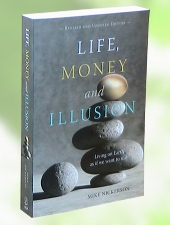Sustainability
- a choice to consider
Visioning: Sustainability and Community Planning
Any exercise to envision the future, is well served by clearly
identifying what is possible and desirable.
It is widely accepted that we must provide for our needs in a manner
that does not diminish the ability of future generations to provide for
their needs. Clear understanding of what serves this goal and what inhibits
it is important. There is no point in planning and developing our communities
only to find after some years that we are making some problems worse and
must start planning all over again.
What it takes to sustain our communities is much debated. The following
guidelines are offered here as a reference for anchoring this critical debate
and pushing it toward resolution. They were derived from an inventory of
the possibilities and limitations as seen by volunteers and non-profit groups.

Sustainability
ACTIVITIES ARE SUSTAINABLE WHEN THEY:
#1 Use materials in continuous cycles.
#2 Use continuously reliable sources of energy.
#3 Come mainly from the qualities of being human (i.e. creativity, communication,
coordination, appreciation, and spiritual and intellectual development.)
ACTIVITIES ARE NOT SUSTAINABLE WHEN THEY:
#4 Require continual inputs of non-renewable resources.
#5 Use renewable resources faster than their rate of renewal.
#6 Cause cumulative degradation of the environment.
#7 Require resources in quantities that undermine other people's well-being.
#8 Lead to the extinction of other life forms. Using these points as a reference,
we can ask?
- Is this what we mean by sustainability?
- If it is not, upon what point or points do we disagree?
- For what reasons?
- Is there anything missing?
Some say the word sustainability has been discredited by
spin doctors working for vested interests. We need only witness how the
people with such interests avoid these basic questions to see the advantage
of claiming sustainability as a popular goal.
Only good can come from pointing out and discussing mistakes and omissions
in the guidelines above. If, however, they stand to reason, should we not
be up front about what must be accomplished in the next generation or so?
Watch out!
The implications are extensive and can be overwhelming.
In the words of psychologist, Daniel Goleman:
"There is an almost gravitational pull toward putting out
of mind unpleasant facts . . .
We tune out, we turn away, we avoid. Finally we forget, and we forget we
have forgotten."
It's easily done, it's human nature and in many instances it is a useful
survival trait as it enables us to act in circumstances which might otherwise
be paralyzing. It is not, however, appropriate to approach the planning
process in a state of denial.
Like the shield of Perseus, the planning process enables us to deal
with problems before their full impact renders us immobile. Perseus had
to face Medusa, a creature so horrible that any who looked at her directly
turned to stone. By looking only at her reflection in his shield, Perseus
was able to slay Medusa and release the local community from its long-term
problem.
The planning process, enables us to recognize long-term problems and
make plans for dealing with them before our vision is clouded by denial
and vested interest.
We humans are remarkably capable. If we can get the challenge right,
then our collective understanding, skills, ingenuity, and resources could
lay the ground work for communities that will serve the interests of the
next seven generations and beyond. Any community which does so in full recognition
of what long-term tenure on Earth requires will create a symbol of hope
that could be felt around the world.
More detail is available in Life Based Purpose;
A Solution and Let's Talk About Sustainability


